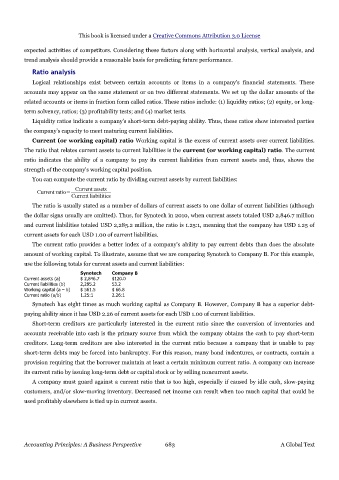Page 682 - Accounting Principles (A Business Perspective)
P. 682
This book is licensed under a Creative Commons Attribution 3.0 License
expected activities of competitors. Considering these factors along with horizontal analysis, vertical analysis, and
trend analysis should provide a reasonable basis for predicting future performance.
Ratio analysis
Logical relationships exist between certain accounts or items in a company's financial statements. These
accounts may appear on the same statement or on two different statements. We set up the dollar amounts of the
related accounts or items in fraction form called ratios. These ratios include: (1) liquidity ratios; (2) equity, or long-
term solvency, ratios; (3) profitability tests; and (4) market tests.
Liquidity ratios indicate a company's short-term debt-paying ability. Thus, these ratios show interested parties
the company's capacity to meet maturing current liabilities.
Current (or working capital) ratio Working capital is the excess of current assets over current liabilities.
The ratio that relates current assets to current liabilities is the current (or working capital) ratio. The current
ratio indicates the ability of a company to pay its current liabilities from current assets and, thus, shows the
strength of the company's working capital position.
You can compute the current ratio by dividing current assets by current liabilities:
Current assets
Current ratio=
Current liabilities
The ratio is usually stated as a number of dollars of current assets to one dollar of current liabilities (although
the dollar signs usually are omitted). Thus, for Synotech in 2010, when current assets totaled USD 2,846.7 million
and current liabilities totaled USD 2,285.2 million, the ratio is 1.25:1, meaning that the company has USD 1.25 of
current assets for each USD 1.00 of current liabilities.
The current ratio provides a better index of a company's ability to pay current debts than does the absolute
amount of working capital. To illustrate, assume that we are comparing Synotech to Company B. For this example,
use the following totals for current assets and current liabilities:
Synotech Company B
Current assets (a) $ 2,846.7 $120.0
Current liabilities (b) 2,285.2 53.2
Working capital (a – b) $ 561.5 $ 66.8
Current ratio (a/b) 1.25:1 2.26:1
Synotech has eight times as much working capital as Company B. However, Company B has a superior debt-
paying ability since it has USD 2.26 of current assets for each USD 1.00 of current liabilities.
Short-term creditors are particularly interested in the current ratio since the conversion of inventories and
accounts receivable into cash is the primary source from which the company obtains the cash to pay short-term
creditors. Long-term creditors are also interested in the current ratio because a company that is unable to pay
short-term debts may be forced into bankruptcy. For this reason, many bond indentures, or contracts, contain a
provision requiring that the borrower maintain at least a certain minimum current ratio. A company can increase
its current ratio by issuing long-term debt or capital stock or by selling noncurrent assets.
A company must guard against a current ratio that is too high, especially if caused by idle cash, slow-paying
customers, and/or slow-moving inventory. Decreased net income can result when too much capital that could be
used profitably elsewhere is tied up in current assets.
Accounting Principles: A Business Perspective 683 A Global Text

